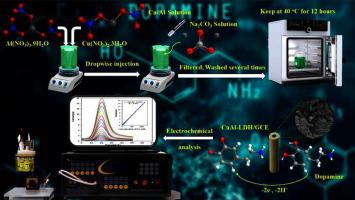当前位置:
X-MOL 学术
›
Electrochem. Commun.
›
论文详情
Our official English website, www.x-mol.net, welcomes your feedback! (Note: you will need to create a separate account there.)
Development of an efficient electrochemical sensor based on CuAl-LDH using an electrostatic repulsion approach for the selective determination of dopamine in the presence of uric acid and ascorbic acid species
Electrochemistry Communications ( IF 4.7 ) Pub Date : 2024-05-19 , DOI: 10.1016/j.elecom.2024.107756 Saeedeh Shahparast , Karim Asadpour-Zeynali
Electrochemistry Communications ( IF 4.7 ) Pub Date : 2024-05-19 , DOI: 10.1016/j.elecom.2024.107756 Saeedeh Shahparast , Karim Asadpour-Zeynali

|
This study provides a unique electrochemical sensor that exhibits both excellent sensitivity and selectivity, while also being environmentally friendly. The CuAl-LDH/GCE sensor, proposed as the recommended sensor, was synthesized using a straightforward one-step co-precipitation procedure. It was first used to measure dopamine levels using differential pulse voltammetry. At the ideal pH level of 8, dopamine has a positive charge, but ascorbic acid and uric acid have a negative charge. LDH, on the other hand, carries a negative charge and exhibits high electrostatic attraction towards dopamine, but is electrostatically repelled by negatively charged ascorbic acid and uric acid. Hence, CuAl-LDH/GCE has the potential to specifically ascertain the existence of dopamine in the presence of these particular species. The examination of the composition and morphology of CuAl-LDH was conducted using various analytical techniques, including scanner electron microscopy (FESEM), transmission electron microscope (TEM), element mapping (MAP), Fourier transform infrared (FTIR), energy-dispersive X-ray spectroscopy (EDX), Brunauer Emmett Teller (BET), X-ray photoelectron diffraction (XRD), and Raman techniques. Under ideal circumstances, the calibration graph of dopamine was generated using differential pulse voltammetry. A linear range of 4.194–1151.54 μM was achieved for dopamine, with a limit of detection of 0.33 μM. The findings of the study indicate that the sensor created for dopamine determination has exceptional stability, repeatability, and reproducibility. The sensor that was presented was effectively used for the measurement of dopamine in both pharmaceutical ampoules and human plasma samples.
中文翻译:

开发基于 CuAl-LDH 的高效电化学传感器,利用静电排斥方法选择性测定尿酸和抗坏血酸物质存在下的多巴胺
这项研究提供了一种独特的电化学传感器,它具有出色的灵敏度和选择性,同时也对环境友好。 CuAl-LDH/GCE 传感器被提议作为推荐传感器,是使用简单的一步共沉淀程序合成的。它首先用于使用微分脉冲伏安法测量多巴胺水平。在理想的 pH 值 8 下,多巴胺带正电荷,但抗坏血酸和尿酸带负电荷。另一方面,LDH 带有负电荷,对多巴胺表现出高静电吸引力,但会受到带负电的抗坏血酸和尿酸的静电排斥。因此,CuAl-LDH/GCE 有潜力特异性确定这些特定物种存在下多巴胺的存在。使用各种分析技术对 CuAl-LDH 的成分和形貌进行了检查,包括扫描电子显微镜 (FESEM)、透射电子显微镜 (TEM)、元素映射 (MAP)、傅里叶变换红外 (FTIR)、能量色散 X射线光谱 (EDX)、Brunauer Emmett Teller (BET)、X 射线光电子衍射 (XRD) 和拉曼技术。在理想情况下,使用微分脉冲伏安法生成多巴胺的校准图。多巴胺的线性范围为 4.194–1151.54 μM,检测限为 0.33 μM。研究结果表明,用于测定多巴胺的传感器具有出色的稳定性、重复性和再现性。所提出的传感器可有效用于测量药物安瓿和人血浆样品中的多巴胺。
更新日期:2024-05-19
中文翻译:

开发基于 CuAl-LDH 的高效电化学传感器,利用静电排斥方法选择性测定尿酸和抗坏血酸物质存在下的多巴胺
这项研究提供了一种独特的电化学传感器,它具有出色的灵敏度和选择性,同时也对环境友好。 CuAl-LDH/GCE 传感器被提议作为推荐传感器,是使用简单的一步共沉淀程序合成的。它首先用于使用微分脉冲伏安法测量多巴胺水平。在理想的 pH 值 8 下,多巴胺带正电荷,但抗坏血酸和尿酸带负电荷。另一方面,LDH 带有负电荷,对多巴胺表现出高静电吸引力,但会受到带负电的抗坏血酸和尿酸的静电排斥。因此,CuAl-LDH/GCE 有潜力特异性确定这些特定物种存在下多巴胺的存在。使用各种分析技术对 CuAl-LDH 的成分和形貌进行了检查,包括扫描电子显微镜 (FESEM)、透射电子显微镜 (TEM)、元素映射 (MAP)、傅里叶变换红外 (FTIR)、能量色散 X射线光谱 (EDX)、Brunauer Emmett Teller (BET)、X 射线光电子衍射 (XRD) 和拉曼技术。在理想情况下,使用微分脉冲伏安法生成多巴胺的校准图。多巴胺的线性范围为 4.194–1151.54 μM,检测限为 0.33 μM。研究结果表明,用于测定多巴胺的传感器具有出色的稳定性、重复性和再现性。所提出的传感器可有效用于测量药物安瓿和人血浆样品中的多巴胺。











































 京公网安备 11010802027423号
京公网安备 11010802027423号